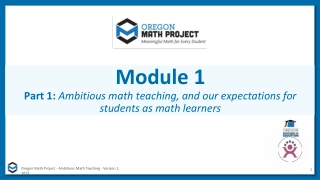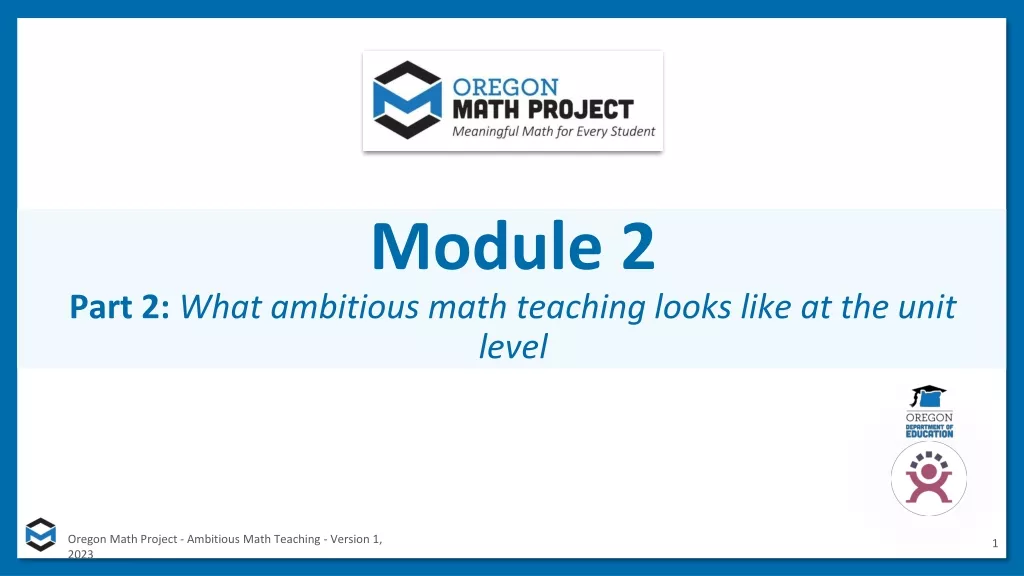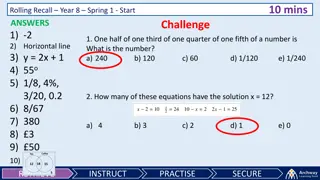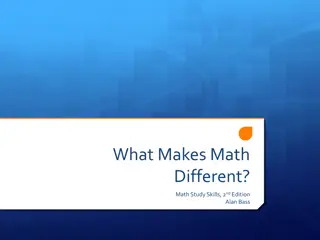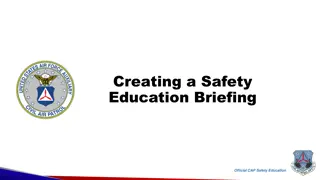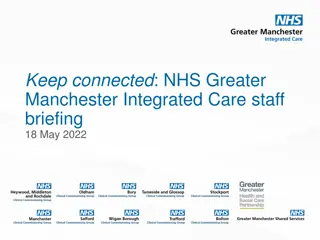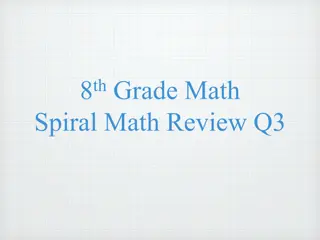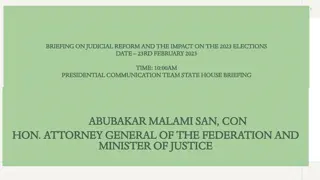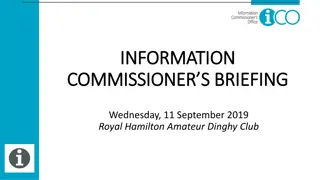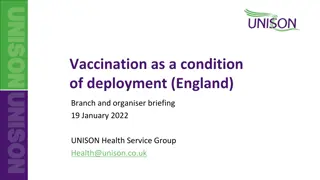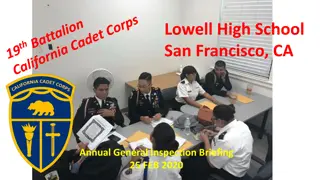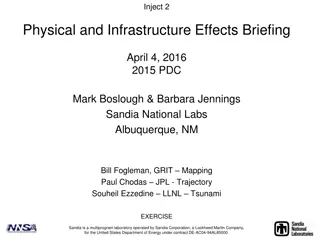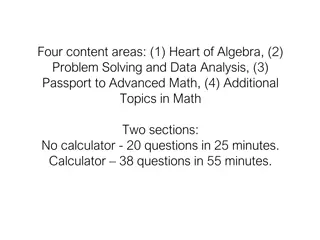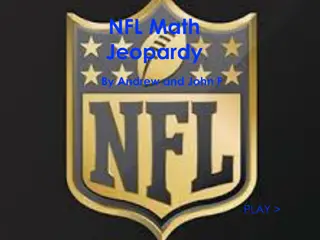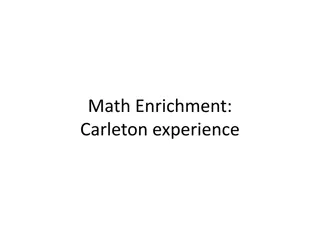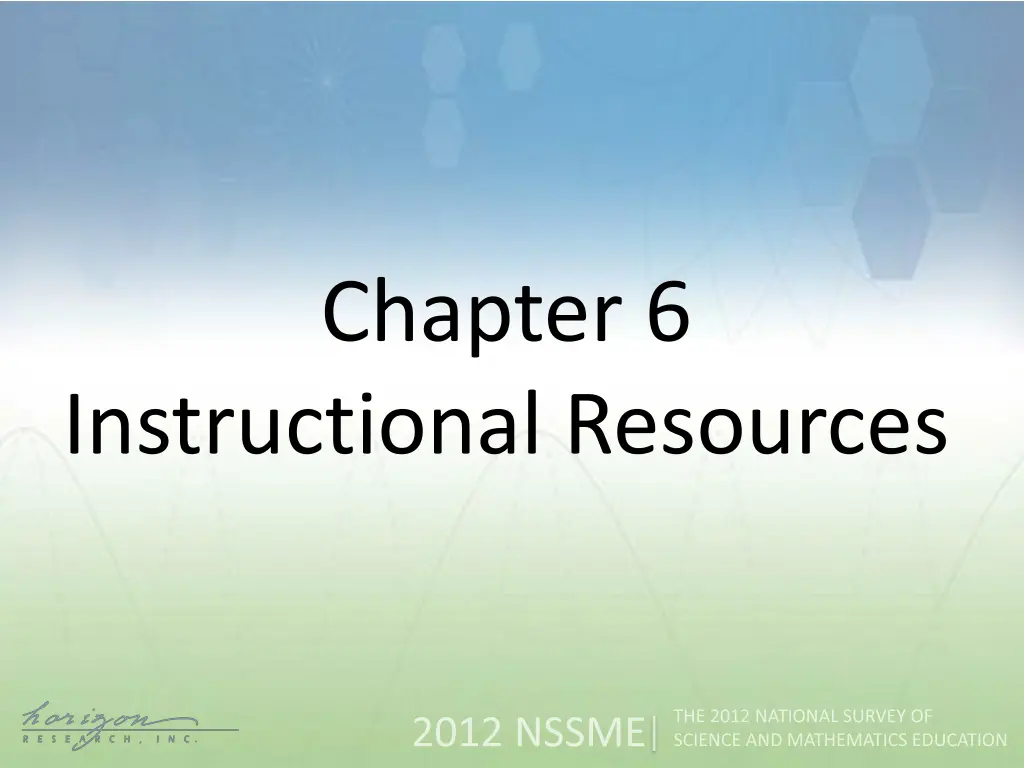
Instructional Resources and Materials for Mathematics Classes
Explore insights into the usage of instructional resources and materials in mathematics classes across different grade levels, including the market share of commercial textbook publishers. Discover trends in the adoption of various teaching materials to enhance mathematics education.
Download Presentation

Please find below an Image/Link to download the presentation.
The content on the website is provided AS IS for your information and personal use only. It may not be sold, licensed, or shared on other websites without obtaining consent from the author. If you encounter any issues during the download, it is possible that the publisher has removed the file from their server.
You are allowed to download the files provided on this website for personal or commercial use, subject to the condition that they are used lawfully. All files are the property of their respective owners.
The content on the website is provided AS IS for your information and personal use only. It may not be sold, licensed, or shared on other websites without obtaining consent from the author.
E N D
Presentation Transcript
Chapter 6 Instructional Resources
Original Data for Slide 5 (not for presentation) Table 6.1 Classes Using Commercially Published Textbooks/Programs, by Subject Elementary School Middle School High School Percent of Classes Mathematics 85 81 81 (1.5) (1.8) (1.0)
Mathematics Classes Using Commercially Published Textbooks/Programs, by Grade Range 100 85 81 81 80 Percent of Classes 60 40 20 0 Elementary Middle High
Original Data for Slide 7 (not for presentation) Table 6.2 Instructional Materials Used in Mathematics Classes, by Grade Range Percent of Classes Middle (2.2) 55 (2.4) (1.6) 27 (2.1) (1.5) 19 (1.8) Elementary 62 23 15 High 65 16 19 One commercially published textbook or program most of the time Multiple commercially published textbooks/programs most of the time Non-commercially published instructional materials most of the time (1.4) (0.9) (1.0)
Instructional Materials Used in Mathematics Classes, by Grade Range 100 80 Percent of Classes 65 62 55 60 40 27 23 19 19 16 15 20 0 Elementary Middle High One published textbook/program Multiple published textbooks/programs Non-commercial instructional materials
Original Data for Slide 9 (not for presentation) Table 6.4 Market Share of Commercial Textbook Publishers , by Subject and Grade Range Mathematics Houghton Mifflin Harcourt Pearson McGraw-Hill Cengage Learning W. H. Freeman Only publishers with two percent or more of the market share in any grade range are included in this table. No teachers at this grade level in the sample reported using materials from this publisher. Thus, it is not possible to calculate the standard error of this estimate. Percent of Classes Middle (2.7) 41 (3.0) 26 (2.5) 28 --- --- Elementary 35 33 29 0 0 High 35 (1.6) 30 (2.0) 18 (1.6) 9 (1.0) 2 (0.6) (3.2) (2.5) (2.8) --- --- 0 0
Market Share of Commercial Textbook Publishers in Mathematics Classes, by Grade Range 60 41 Percent of Classes 40 35 35 33 30 29 28 26 18 20 0 Elementary Middle High Houghton Mifflin Harcourt Pearson McGraw-Hill
Original Data for Slide 11 (not for presentation) Table 6.8 Publication Year of Textbooks/Programs, by Subject and Grade Range Elementary Mathematics 2006 or earlier 30 2007 09 52 2010 12 18 Only classes using published textbooks/modules were included in these analyses. Percent of Classes Middle High 52 33 15 (2.4) (2.5) (2.3) (2.4) (2.6) (1.4) 40 44 16 (1.9) (1.6) (1.0)
Publication Year of Mathematics Textbooks/Programs, by Grade Range 60 52 52 44 40 Percent of Classes 40 33 30 18 20 16 15 0 Elementary Middle High 2006 or earlier 2007 2009 2010 2012
Original Data for Slide 13 (not for presentation) Table 6.9 Perceived Quality of Textbooks/Programs Used in Classes, by Subject and Grade Range Elementary 1 3 20 38 30 9 Only classes using published textbooks/programs were included in these analyses. Percent of Classes Middle High 1 4 16 33 37 8 Mathematics Very Poor Poor Fair Good Very Good Excellent (0.6) (0.9) (2.4) (2.5) (2.5) (1.4) (1.2) (0.9) (2.4) (2.6) (2.9) (1.6) 2 4 (0.4) (0.8) (1.3) (2.5) (2.3) (1.0) 19 34 33 9
Perceived Quality of Textbooks/Programs Used in Mathematics Classes, by Grade Range 60 45 41 Percent of Classes 38 38 40 34 33 20 19 20 16 6 5 5 0 Elementary Middle High Poor Fair Good Very Good
Original Data for Slide 15 (not for presentation) Table 6.10 Percentage of Textbooks/Programs Covered during the Course, by Subject and Grade Range Elementary Percent of Classes Middle High 1 7 25 67 Mathematics Less than 25 percent 25 49 percent 50 74 percent 75 100 percent Only classes using published textbooks/programs were included in these analyses (0.8) (1.3) (1.8) (2.4) (0.7) (2.1) (3.1) (3.5) 2 5 2 7 (0.4) (1.2) (2.1) (2.1) 13 81 22 69
Percentage of Textbooks/Programs Covered during the Mathematics Course, by Grade Range 100 81 80 69 67 Percent of Classes 60 40 25 22 20 13 7 7 5 2 2 1 0 Elementary Middle High <25 percent 25 49 percent 50 74 percent 75 100 percent
Original Data for Slide 17 (not for presentation) Table 6.11 Percentage of Instructional Time Spent Using Instructional Materials during the Course, by Grade Range Elementary Mathematics Less than 25 percent 25 49 percent 50 74 percent 75 percent or more Only classes using published textbooks/programs were included in these analyses Percent of Classes Middle High 21 14 20 45 4 (1.2) (2.3) (2.6) (3.4) 14 14 23 49 (2.0) (1.9) (3.2) (3.5) (2.2) (1.7) (1.7) (2.7) 12 20 64
Percentage of Time Spent Using Instructional Materials during the Mathematics Course, by Grade Range 80 64 60 Percent of Classes 49 45 40 23 21 20 20 20 14 14 14 12 4 0 Elementary Middle High <25 percent 25 49 percent 50 74 percent 75 100 percent
Original Data for Slide 19 (not for presentation) Table 6.12 Ways Teachers Substantially Used Their Textbook in the Most Recent Unit, by Grade Range Percent of Classes Middle Elementary High Mathematics Classes You incorporated activities (e.g., problems, investigations, readings) from other sources to supplement what the textbook/ program was lacking You used the textbook/program to guide the overall structure and content emphasis of the unit You picked what is important from the textbook/program and skipped the rest You followed the textbook/program to guide the detailed structure and content emphasis of the unit Includes those responding 4 or 5 on a 5-point scale ranging from 1 not at all to 5 to a great extent. Only classes using published textbooks/programs in the most recent unit were included in these analyses. 62 (2.1) 68 (2.6) 56 (1.9) 81 (1.6) 71 (2.2) 74 (1.5) 43 (2.0) 51 (2.5) 52 (1.6) 74 (2.0) 56 (2.7) 57 (1.5)
Ways Mathematics Teachers Substantially Used Their Textbook in the Most Recent Unit, by Grade Range 100 81 74 74 Percent of Classes 80 71 68 62 57 56 56 60 52 51 43 40 20 0 Elementary Middle High Used activities to supplement textbook Used textbook to guide the overall structure/content of unit Picked important material and skipped the rest Followed textbook to guide the detailed structure/content of unit
Original Data for Slides 2123 (not for presentation) Table 6.13 Reasons Why Parts of the Textbook Are Skipped, by Grade Range Percent of Classes Middle Mathematics Classes You have different activities for those mathematical ideas that work better than the ones you skipped The mathematical ideas addressed in the activities you skipped are not included in your pacing guide and/or current state standards Your students already knew the mathematical ideas or were able to learn them without the activities you skipped You did not have the materials needed to implement the activities you skipped The activities you skipped were too difficult for your students Only classes using published textbooks/programs in the most recent unit and whose teachers reported skipping some activities were included in these analyses. Elementary High 78 (2.5) 79 (2.9) 79 (2.0) 68 (2.9) 78 (3.2) 66 (2.9) 71 (2.9) 57 (3.9) 54 (2.8) 29 31 (2.9) (3.2) 30 41 (4.4) (3.3) 30 55 (2.7) (2.5)
Reasons Why Parts of the Textbook Are Skipped in Elementary School Mathematics Classes Have different activities that work better than skipped ones 78 Students already knew or were able to learn content without skipped activities 71 Mathematical ideas skipped are not included in current curriculum 68 Skipped activities were too difficult for students 31 Did not have materials needed to implement skipped activities 29 0 20 40 60 80 100 Percent of Classes
Reasons Why Parts of the Textbook Are Skipped in Middle School Mathematics Classes Have different activities that work better than skipped ones 79 Mathematical ideas skipped are not included in current curriculum 78 Students already knew or were able to learn content without skipped activities 57 Skipped activities were too difficult for students 41 Did not have materials needed to implement skipped activities 30 0 20 40 60 80 100 Percent of Classes
Reasons Why Parts of the Textbook Are Skipped in High School Mathematics Classes Have different activities that work better than skipped ones 79 Mathematical ideas skipped are not included in current curriculum 66 Skipped activities were too difficult for students 55 Students already knew or were able to learn content without skipped activities 54 Did not have materials needed to implement skipped activities 30 0 20 40 60 80 100 Percent of Classes
Original Data for Slides 2527 (not for presentation) Table 6.14 Reasons Why the Textbook Is Supplemented, by Grade Range Percent of Classes Middle Mathematics Classes Supplemental activities were needed to provide students with additional practice Supplemental activities were needed so students at different levels of achievement could increase their understanding of the ideas targeted in each activity Supplemental activities were needed to prepare students for standardized tests Your pacing guide indicated that you should use supplemental activities Only classes using published textbooks/programs in the most recent unit and whose teachers reported supplementing with additional activities were included in these analyses. Elementary High 95 (1.5) 96 (1.1) 94 (1.3) 96 (1.0) 97 (1.0) 91 (1.7) 65 (2.7) 72 (4.4) 55 (2.6) 49 (3.1) 40 (4.2) 36 (2.1)
Reasons Why the Textbook Is Supplemented in Elementary School Mathematics Classes To accommodate students at different levels of achievement 96 To provide students with additional practice 95 To prepare students for standardized tests 65 Pacing guide indicated that supplemental activities should be used 49 0 20 40 60 80 100 Percent of Classes
Reasons Why the Textbook Is Supplemented in Middle School Mathematics Classes To accommodate students at different levels of achievement 97 To provide students with additional practice 96 To prepare students for standardized tests 72 Pacing guide indicated that supplemental activities should be used 40 0 20 40 60 80 100 Percent of Classes
Reasons Why the Textbook Is Supplemented in High School Mathematics Classes To provide students with additional practice 94 To accommodate students at different levels of achievement 91 To prepare students for standardized tests 55 Pacing guide indicated that supplemental activities should be used 36 0 20 40 60 80 100 Percent of Classes
Facilities and Equipment
Original Data for Slides 3032 (not for presentation) Table 6.17 Availability of Instructional Technologies in Mathematics Classes, by Grade Range Percent of Classes Middle (1.9) 50 (2.2) 69 (1.9) 80 (3.0) 77 (2.5) 68 Elementary 11 16 80 58 68 High 83 74 70 61 58 Graphing calculators Scientific calculators Internet access Four-function calculators Personal computers, including laptops Classroom response system or Clickers (handheld devices used to respond electronically to questions in class) Probes for collecting data (e.g., motion sensors, temperature probes) Hand-held computers (e.g., PDAs, tablets, smartphones, iPads) Includes only those rating the availability as at least one per group available, either in the classroom, upon request, or in another room. (2.9) (2.7) (2.0) (2.0) (2.5) (1.7) (1.7) (1.9) (1.9) (2.3) 39 19 17 (2.6) (2.0) (2.2) 53 18 21 (3.0) (2.1) (2.5) 44 26 17 (2.5) (2.2) (1.4)
Availability of Instructional Technologies in Elementary School Mathematics Classes Internet access 80 Personal computers, including laptops 68 Four-function calculators 58 Classroom response system or Clickers 39 Probes for collecting data 19 Hand-held computers 17 Scientific calculators 16 Graphing calculators 11 0 20 40 60 80 100 Percent of Classes
Availability of Instructional Technologies in Middle School Mathematics Classes Internet access 80 Four-function calculators 77 Scientific calculators 69 Personal computers, including laptops 68 Classroom response system or Clickers 53 Graphing calculators 50 Hand-held computers 21 Probes for collecting data 18 0 20 40 60 80 100 Percent of Classes
Availability of Instructional Technologies in High School Mathematics Classes Graphing calculators 83 Scientific calculators 74 Internet access 70 Four-function calculators 61 Personal computers, including laptops 58 Classroom response system or Clickers 44 Probes for collecting data 26 Hand-held computers 17 0 20 40 60 80 100 Percent of Classes
Original Data for Slide 34 (not for presentation) Table 6.18 Availability of Instructional Technologies in Mathematics Classes, by Percent of Non-Asian Minority Students in Class Percent of Classes Second Quartile 50 (3.5) 44 (3.0) 18 (2.2) Lowest Quartile 58 53 30 Third Quartile 43 39 20 Highest Quartile 37 34 16 Scientific calculators Graphing calculators Probes for collecting data Availability defined as having at least one instructional technology per small group (4 5 students). (2.4) (2.6) (2.4) (3.1) (3.2) (3.0) (3.2) (3.2) (2.0)
Availability of Instructional Technologies in Mathematics Classes, by Percentage of Students in Class from Historically Underrepresented Race/Ethnicity Groups 100 80 Percent of Classes 58 60 53 50 44 43 39 37 34 40 30 20 18 16 20 0 Scientific calculators Graphing calculators Probes for collecting data Lowest % Underrepresented Second Quartile Third Quartile Highest % Underrepresented
Original Data for Slide 36 (not for presentation) Table 6.20 Median Amount Schools Spend per Pupil on Science and Mathematics Equipment and Consumable Supplies, by Grade Range Median Amount Middle $ 0.73 $ 0.64 $ 2.76 Elementary $ 0.95 $ 1.08 $ 4.27 High Mathematics Equipment Consumable Supplies Total The survey asked about spending on software in addition to equipment and supplies. The median per pupil spending on software in each subject/grade-range combination is $0.00. Standard errors for medians are typically computed in Wesvar 5.1 using the Woodruff method. Wesvar was unable to compute a standard error for this estimate using this method; thus, the potentially less-consistent replication standard error is reported. Includes spending on software. (0.2) (0.2) (0.7) (0.1) (0.1) (0.4) (0.2) (0.1) (0.4) $ 1.05 $ 0.61 $ 2.46
Median Amount Schools Spend per Pupil on Mathematics Equipment and Consumable Supplies, by Grade Range $5.00 $4.27 $4.00 Median Amount $2.76 $3.00 $2.46 $2.00 $1.08 $1.05 $0.95 $1.00 $0.73 $0.64 $0.61 $0.00 Elementary Middle High Equipment Consumable Supplies Total
Original Data for Slides 3841 (not for presentation) Table 6.22 Median Amount Schools Spend per Pupil on Mathematics Equipment and Consumable Supplies, by Equity Factors Median Amount Consumable Supplies $ 1.06 $ 0.66 $ 0.99 $ 0.65 $ 0.86 $ 0.68 $ 0.92 $ 0.61 $ 1.01 $ 0.89 $ 0.49 $ 0.70 $ 1.11 $ 0.64 $ 0.91 Total $ 3.60 $ 2.75 $ 3.69 $ 3.37 Equipment $ 0.93 $ 0.82 $ 1.02 $ 0.92 $ 1.11 $ 0.82 $ 0.66 $ 0.68 $ 1.29 $ 0.81 $ 0.58 $ 0.72 $ 2.22 $ 0.89 $ 0.72 Percent of Students in School Eligible for FRL Lowest Quartile Second Quartile Third Quartile Highest Quartile School Size Smallest Schools Second Group Third Group Largest Schools Community Type Rural Suburban Urban Region Midwest Northeast South West The Total column includes spending on software. (0.2) (0.2) (0.2) (0.1) (0.2) (0.2) (0.1) (0.2) (0.3) (0.1) (0.1) (0.2) (0.5) (0.2) (0.2) (0.3) (0.1) (0.2) (0.2) (0.2) (0.2) (0.2) (0.1) (0.2) (0.1) (0.1) (0.2) (0.4) (0.1) (0.2) (0.8) (0.4) (0.6) (1.0) (0.8) (0.5) (0.4) (0.5) (0.7) (0.5) (0.5) (0.6) (1.4) (0.5) (0.7) $ 3.93 $ 3.44 $ 2.75 $ 2.06 $ 4.58 $ 2.98 $ 2.45 $ 3.25 $ 5.18 $ 2.93 $ 2.19
Median Amount Schools Spend per Pupil on Mathematics Equipment and Consumable Supplies, by Percentage of Students in School Eligible for Free/Reduced-Price Lunch $6.00 $5.00 Median Amount $3.69 $4.00 $3.60 $3.37 $2.75 $3.00 $2.00 $1.00 $0.00 Lowest Poverty Schools Quartile of Schools Based on Percentage of Students Eligible for Free/Reduced-Price Lunch Second Quartile Third Quartile Highest Poverty Schools
Median Amount Schools Spend per Pupil on Mathematics Equipment and Consumable Supplies, by School Size $6.00 $5.00 $3.93 Median Amount $4.00 $3.44 $2.75 $3.00 $2.06 $2.00 $1.00 $0.00 Smallest Schools Second Group Quartile of Schools Based on School Size Third Group Largest Schools
Median Amount Schools Spend per Pupil on Mathematics Equipment and Consumable Supplies, by Community Type $6.00 $5.00 $4.58 Median Amount $4.00 $2.98 $3.00 $2.45 $2.00 $1.00 $0.00 Rural Suburban Community Type Urban
Median Amount Schools Spend per Pupil on Mathematics Equipment and Consumable Supplies, by Region $6.00 $5.18 $5.00 Median Amount $4.00 $3.25 $2.93 $3.00 $2.19 $2.00 $1.00 $0.00 Midwest Northeast South West Region
Original Data for Slide 43 (not for presentation) Table 6.24 Mathematics Classes with Adequate Resources for Instruction, by Grade Range Percent of Classes Middle (1.9) 70 (2.1) 62 (1.8) 62 (1.8) 58 Measurement tools (e.g., protractors, rulers) Instructional technology (e.g., calculators, computers, probes/sensors) Consumable supplies (e.g., graphing paper, batteries) Manipulatives (e.g., pattern blocks, algebra tiles) Includes those responding 4 or 5 on a 5-point scale ranging from 1 not adequate to 5 adequate. Elementary 67 50 57 82 High 70 69 66 43 (2.1) (2.2) (2.3) (2.1) (1.4) (1.7) (1.7) (1.7)
Mathematics Classes with Adequate Resources for Instruction, by Grade Range 100 82 80 70 70 69 Percent of Classes 67 66 62 62 58 57 60 50 43 40 20 0 Elementary Middle High Measurement tools Instructional technology Consumable supplies Manipulatives
Original Data for Slides 4547 (not for presentation) Table 6.26 Class Mean Scores on the Adequacy of Resources for Instruction Composite, by Equity Factors Mean Score Mathematics 74 70 68 73 71 70 69 73 71 69 68 Prior Achievement Level of Class Mostly High Achievers Average/Mixed Achievers Mostly Low Achievers Percent of Non-Asian Minority Students in Class Lowest Quartile Second Quartile Third Quartile Highest Quartile Percent of Students in School Eligible for FRL Lowest Quartile Second Quartile Third Quartile Highest Quartile (0.9) (0.7) (1.4) (0.9) (1.1) (1.0) (1.3) (1.3) (1.0) (1.1) (1.4)
Mathematics Class Mean Scores on the Adequacy of Resources for Instruction Composite, by Prior Achievement of Class 100 80 74 70 68 Class Mean Score 60 40 20 0 Mostly Low Achievers Average/Mixed Achievers Mostly High Achievers Prior Achievement Level of Class
Mathematics Class Mean Scores on the Adequacy of Resources for Instruction Composite, by Percentage of Students in Class from Historically Underrepresented Race/Ethnicity Groups 100 80 73 71 70 69 Class Mean Score 60 40 20 0 Lowest % Underrepresented Second Quartile Third Quartile Highest % Underrepresented Quartiles of Classes Based on Percentage of Historically Underrepresented Students in Class
Mathematics Class Mean Scores on the Adequacy of Resources for Instruction Composite, by Percentage of Students in School Eligible for Free/Reduced-Price Lunch 100 80 73 71 69 Class Mean Score 68 60 40 20 0 Lowest Poverty Schools Quartile of Schools Based on Percentage of Students Eligible for Free/Reduced-Price Lunch Second Quartile Third Quartile Highest Poverty Schools

